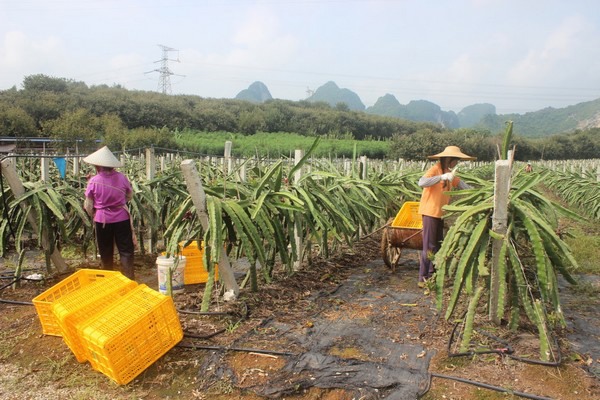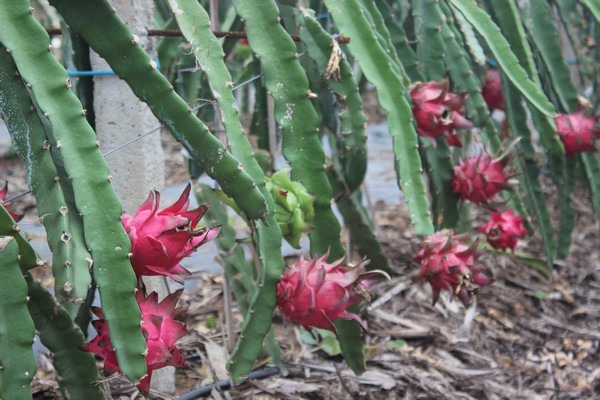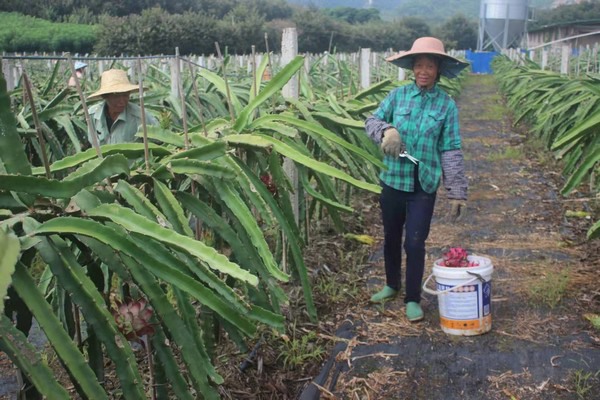The first red dragon fruit of the season entered the Chinese market on the 20th of June. The weather conditions were excellent in Guangxi this year, and both the product quality as well as the production volume of dragon fruit are better than last year. Mr. Dong is the spokesperson for Long Yi Sheng Fruit Industry, a dragon fruit producer based in Nanning, Guangxi. Mr. Dong recently talked about current market conditions for red dragon fruit.

"Although the production volume and product quality are both equally great this year, we are still somewhat worried about the sales conditions this year," said manager Dong. "Dragon fruit is generally bought by supermarkets, but also by restaurants, karaoke places, and rinks shops. However, these industries have suffered a lot from lockdowns during the pandemic. That put a severe limit on the demand for dragon fruit. Intermediaries are worried about future lockdowns and they therefore reduced the volumes they ordered from producers. The price of red dragon fruit from larger plantations is around 1.6-1.8 yuan [0.25-0.28 USD] per 0.5 kg. In some smaller plantations the price is even lower. The overall market price of dragon fruit is much lower than last year."

Every year, Vietnam exports huge volumes of dragon fruit to China. When asked about the conditions of Vietnamese dragon fruit import in China, manager Dong replied, "90% of the dragon fruit sold in China comes from Vietnam. However, the pandemic has created a lot of obstacles for international trade. The Chinese import volume of Vietnamese dragon fruit is much smaller this year. The overland route from Vietnam to China across the Guangxi border used to take 2-3 days, but can now take up to a week. That is why the Chinese import volume of Vietnamese dragon fruit recently declined by 50%. This is of course an opportunity for domestic dragon fruit. A growing number of Chinese consumers have quickly become familiar with domestic dragon fruit."

Manager Dong also made a comparison between domestic dragon fruit and Vietnamese dragon fruit. "Vietnamese dragon fruit has a deeper color, and the leaves are green. In general, Vietnamese dragon fruit is prettier. The color of Chinese dragon fruit is shallower and the leaves are not that brightly colored. However, the growing period of Vietnamese dragon fruit is shorter and that is why the flavor is not as good as that of Chinese dragon fruit. The longer growing period of Chinese dragon fruit stimulates the accumulation of sugars, which makes the fruit sweeter than its Vietnamese counterpart. The sugar content of Vietnamese dragon fruit is around 14%-16%, while Chinese dragon fruit is around 16%-20%. As for the price, the production volume of Chinese dragon fruit is smaller and the flavor is superior, so the price is higher," said manager Dong.
"Chinese consumers have never been aware that China also produces sweet dragon fruit. However, now that the domestic dragon fruit is becoming popular, a growing number of farmers is drawn to this industry. The annual production volume rapidly grows. The main production area is in Nanning, Guangxi. The dragon fruit plantations in Guangxi can have around 8-10 harvests per year. The peak period begins in April and continues until January in the subsequent year. The overall surface area devoted to dragon fruit plantation in Guangxi was only around 2,667-3,333 hectares in 2018, but increased nearly fourfold and is now around 12,000 hectares."

Long Yi Sheng Fruit Industry owns a dragon fruit plantation that covers an area of 53 hectares. Their annual production volume is around 2 million kg.
"The dragon fruit industry has rapidly developed in the last few years. The overall surface area devoted to dragon fruit plantation is quickly expanding. Although the outbreak of Covid-19 has put some limits on this growth, and the market has been chaotic for months, the new season is another opportunity for the industry to reach new heights. For example, markets in Wenzhou, a second-tier city in south China, barely sold any domestic dragon fruit in 2019. Wholesale traders solely focused on import dragon fruit from Vietnam. They considered the quality of import dragon fruit higher than domestic dragon fruit. Since the outbreak of Covid-19, and the obstacles it created for international trade, the sales volume of Vietnamese dragon fruit in China has declined. Intermediaries are now shifting their attention to domestic dragon fruit, which can be found in nearly every market in Wenzhou."
For more information:
Mr. Dong
Tel.: 18176235439
WeChat: 18176235439
E-mail: 1091834512@qq.com
